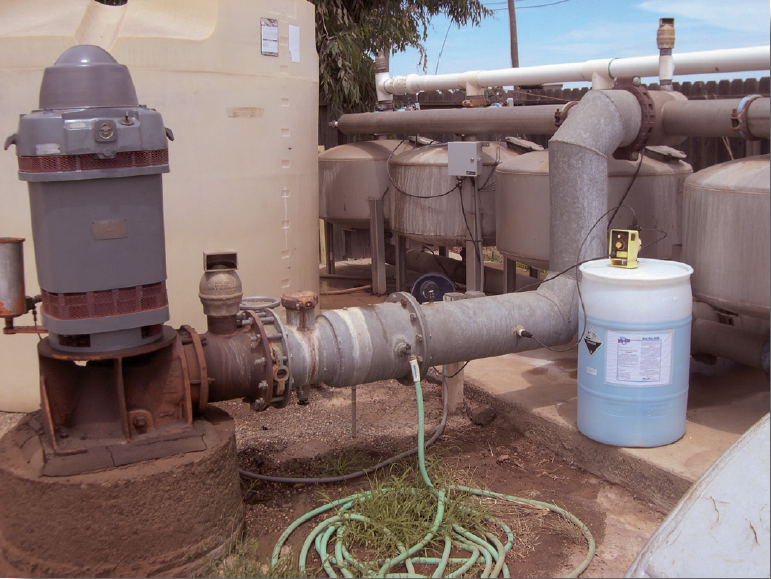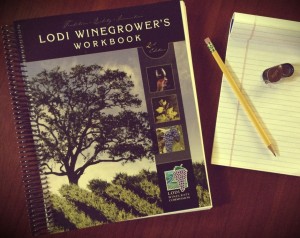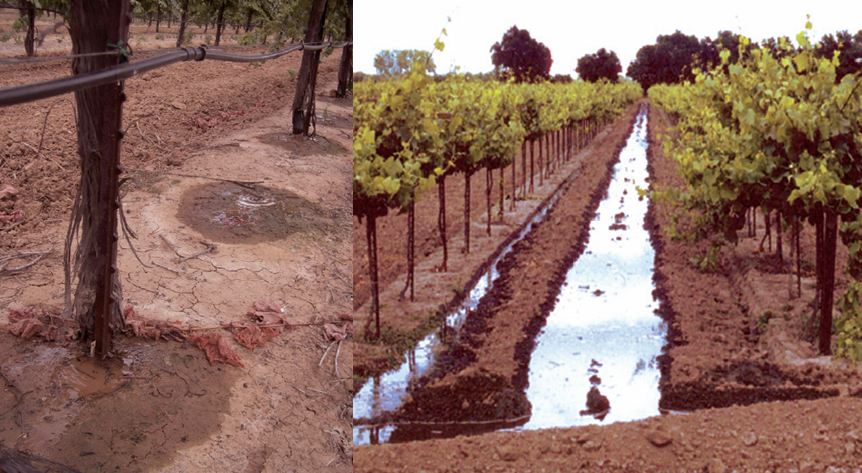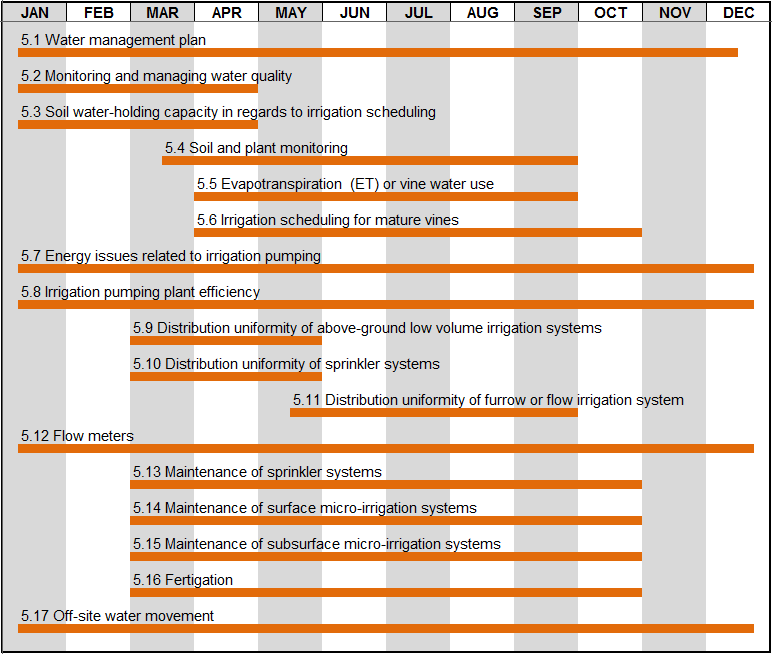Introduction
Describing the issue of water in California, Mark Twain once intoned, “whiskey’s fer drinkin’, water’s fer fightin’.” Winegrapes use less water than most crops, so we do a little less fighting than some, but we still need to manage our most precious resource to the best of our ability.
Drip (or “low volume”) irrigation has revolutionized viticulture. Low volume irrigation systems allow small amounts of water to be applied slowly and frequently through emitters spaced along polyethylene tubing. Furthermore, water is applied uniformly throughout the vineyard. With these systems our vineyards are more uniform, healthier, and make better wine. Unfortunately, for such highly engineered irrigation systems, most are not managed to their full potential. The sleepless nights with a shovel and a thermos are over, but they are replaced with a need for constant monitoring and maintenance. Problems such as clogged emitters rob you of the full benefits of the system.
One of the great advantages of drip irrigation is the control it gives you in deciding exactly how much water to apply and when. However, this flexibility brings with it the responsibility to schedule irrigations appropriately for good vine growth and fruit quality.
__________________________________________________________________________________
This Coffee Shop article is an expert from the Lodi Winegrower’s Workbook (Chapter 5: Water Management). The Workbook is a comprehensive, practical, and user-friendly guide to farming winegrapes. The Lodi Winegrape Commission has handed out hundreds of copies over the years, and growers continue to pick more up at our monthly educational meetings. Workbooks are free to all Crush District 11 (Lodi) growers, and can be ordered from the Commission: (209) 367-4727. Click HERE to learn more.
__________________________________________________________________________________
“Appropriate irrigation scheduling” is an axiom whereby irrigations are scheduled to apply an optimum quantity of water that maximizes productivity. This often results in maintaining soil water content near field capacity. Shortages of water, increased costs of irrigation and the incidence of disease have traditionally been the limiting factors to over irrigating in most annual and perennial crops.
However, in the production of winegrapes, it has long been recognized that water deficits can lead to improved fruit quality —especially in red wine varieties. Originally strategies to achieve water deficits were developed using surface irrigation and relied on irrigation cutoff to limit water as the fruit ripened. This resulted in both successes and failures depending on the timing of the cutoff, climatic and soil storage conditions.
 In recent years, it became clear that maintaining a moderate plant water deficit can improve the partitioning of carbohydrate to reproductive structures (fruit) and also control excessive vegetative growth, giving rise to what has been termed Regulated Deficit Irrigation.
In recent years, it became clear that maintaining a moderate plant water deficit can improve the partitioning of carbohydrate to reproductive structures (fruit) and also control excessive vegetative growth, giving rise to what has been termed Regulated Deficit Irrigation.
Regulated Deficit Irrigation (RDI) is a term for the practice of regulating or restricting the application of irrigation water limiting the vine water use to below that of a fully watered vine. By restricting irrigation water volumes, soil water available to the vine becomes limited to a level where transpiration exceeds water absorption. It is at this point that the vine begins to undergo a water deficit. RDI can be a consistent reduction (i.e., consistent reduction of planned irrigation volumes over the entire season) or a variable reduction over the irrigation season to induce the desired vine response at the appropriate time.
Achievement of successful RDI entails accurate soil moisture or plant ‘stress’ sensing, the ability to estimate crop demand, and the capacity to irrigate frequently using low-volume irrigation. A disadvantage of RDI is that it requires water status to be maintained accurately within a rather narrow tolerance; any excess application loses the advantage of the regulated deficit and can cost more in terms of water used, while any under application can lead to yield or quality losses.
 Regulated Deficit Irrigation can be a component of a “standard” irrigation strategy or utilized in a “drought strategy” to curtail vine water use during periods of limited water availability. Precision micro-irrigation has played a major role in reducing the applied water required in winegrapes by improving emission uniformity. Low volume technology makes possible new irrigation strategies which can further increase water savings as well as improve fruit quality. Vine water status plays a large role in determining the final composition of the fruit, impacting various solutes such as sugar and organic acids which improves the ability for making quality wine.
Regulated Deficit Irrigation can be a component of a “standard” irrigation strategy or utilized in a “drought strategy” to curtail vine water use during periods of limited water availability. Precision micro-irrigation has played a major role in reducing the applied water required in winegrapes by improving emission uniformity. Low volume technology makes possible new irrigation strategies which can further increase water savings as well as improve fruit quality. Vine water status plays a large role in determining the final composition of the fruit, impacting various solutes such as sugar and organic acids which improves the ability for making quality wine.
The potential of drip irrigation as a tool to improve viticulture cannot be overstated. Appropriate irrigation scheduling probably does more for wine quality than any other practice. LWC has funded extensive research on regulated deficit irrigation, and the bottom line is that in the Lodi district, RDI works. Every objective quality parameter is improved, with only a slight negative effect on yield for some varieties. To remain competitive, we absolutely must continue to improve our quality, and regulated deficit irrigation is our main tool.
Developing an irrigation strategy incorporating regulated deficit irrigation principles
 Regulated Deficit Irrigation (RDI) is practiced to limit excessive vegetative growth and improve fruit quality or limit water use in times of drought. If neither of these conditions exist, alternative irrigation strategies may be more appropriate. Some situations when a full water regime is appropriate include young developing vineyards, low vigor vineyards from rootstock/scion selection, limited soil resource or vineyards with nutrition or pest related issues.
Regulated Deficit Irrigation (RDI) is practiced to limit excessive vegetative growth and improve fruit quality or limit water use in times of drought. If neither of these conditions exist, alternative irrigation strategies may be more appropriate. Some situations when a full water regime is appropriate include young developing vineyards, low vigor vineyards from rootstock/scion selection, limited soil resource or vineyards with nutrition or pest related issues.
When selecting an irrigation strategy, it should be designed to address the specific problem, implemented, and then monitored to determine its effect. Adjustments can be made in succeeding years to move towards the desired effects.
A strategy to control excessive vigor and open up the canopy so more diffuse light penetrates to the fruit zone generally requires that no irrigation be applied until shoot growth is under control as a result of reduced water availability in the root zone. Using visual clues or measuring leaf water potential is a successful method allowing the vines to experience moderate water deficits before irrigating. Also, measuring water potential can indicate when water stress is too high so irrigation can forestall canopy/fruit damage. Waiting to apply irrigation until a specific leaf water potential is reached is called the irrigation “Stress Threshold”. This procedure when combined with deficit irrigation is called “ Stress Threshold RDI Irrigation Method”.
Moderate levels of vine water stress vary somewhat by variety and fruit quality goals. White winegrapes can benefit by reducing vegetative growth. However, excessive light on the fruit may create more color and character than desired. Mid-day leaf water potential of -10 to -13 bars is a typical irrigation start point or “Leaf water Potential Stress Threshold” for a white winegrape RDI.
Red winegrapes on the other hand tend to benefit from higher levels of stress. Red winegrapes develop desired fruit characteristics with a more severe Stress Threshold of -13 to -15 bars. Some red grape varieties are more sensitive than others with Merlot being most sensitive and varieties like Cabernet Sauvignon, Syrah and Zinfandel exhibiting more tolerance.
Once an irrigation “Stress Threshold” is selected, the question becomes how much water to apply (a specific RDI %). The RDI is a percentage of the full amount of water that a vine will potentially use based on climatic demand and canopy size when water from the soil is not limited. The selected RDI should prevent shoot growth from resuming but allow photosynthesis to continue, prevent excessive leaf loss, and limit fruit sun burning or raisining.
Successful RDI’s are typically 50 to 60% of full vine water use. More severe RDI’s of 35-40% have resulted in delayed harvest and poor quality fruit in seasons when harvest is late. Deep root zones and clayey soils can sustain vines at lower RDI’s.
Recent research indicates the selection of an RDI at the Stress Threshold to curb vegetative growth, let’s say 50%, may not be adequate to sustain the vine if extended maturity harvests are practiced (i.e. long hang time) or during periods of temperatures above 95°F. When harvests were conducted at 25° Brix, a single RDI from the “Stress Threshold” through harvest worked well. With extended harvest becoming a more common practice, increasing the RDI % from the threshold RDI of 50% when the fruit reach 19° Brix to near 100% has proven to reduce extended maturity yield loss while still producing superior fruit quality.
Monitoring and Managing Water Quality
Testing may need to occur more often in a problem situation where the water quality is dynamic (e.g. high nitrates, salinity, etc.). Research important regional water issues. For example, high levels of iron can be a problem in some areas. The iron precipitates out in the irrigation lines and plugs emitters. Contact local experts such as your UC Farm Advisor, irrigation company, PCA, consultant or analytical laboratory for more information.
Soil Water-holding Capacity in Regards to Irrigation Scheduling
Be aware of the possibility of soil type variation in your vineyard and how it may affect actual soil water-holding capacity. It may be prudent to have soil moisture sensors installed in the vineyard and know the readings that indicate field capacity. If the readings indicate less than field capacity at the beginning of the season then you can initiate irrigation earlier to compensate.
Soil water holding capacity: Water in the soil occupies the soil pores or spaces in between soil particles. The largest pores allow water to pass through filling smaller pores. After irrigation, gravitational forces pull water out of the large pores, leaving water held in the soil only by the attraction of the small pores. Clayey soils have very small pores and will hold more total water per unit volume than sandier soils which have larger pores.
Following a complete soil wetting and subsequent de-watering of the large pores, a typical soil will have about 50% of the pore space filled with water and 50% with air. This condition is called the field capacity or “the full point”. Soils begin to dry from evaporation and vine water use to a point where water becomes too difficult for roots to extract it (“dry point”). Available water holding capacity is the difference between the wet point and dry point. The water available to the entire root zone is determined by multiplying the soil moisture (inches of water per foot of soil) by the root zone depth. Figure 5.1 and Table 5.1 illustrate the relationship between soil texture and available water content. Note that when vines are using the first half of the available water no vine water stress is expected. During use of the last half, water stress is expected and increases as the dry point is approached. Available water increases as soil textures move from sandy towards clayey textures maximizing at a silt loam texture. As soils further increase in clay content, they hold more total water but less of the water is available due to the clay’s ability to hold the water too tightly for the vine to extract.
Soil and Plant Monitoring
No one soil moisture monitoring method is the best. Each technique and device has advantages and disadvantages depending on the use of the measurement. However, since deficit irrigation strategies require a quantitative measurement of soil moisture (used to calculate applied water volumes), neutron probes or dielectric sensors are preferred. Not appropriate for this use: tensiometers, electrical resistance blocks, and the soil feel method. However they are useful for monitoring soil moisture status.

Neutron Probe measures soil water content via a tube placed in the soil. It uses high speed neutrons that bounce off water particles and are captured by a detector placed at different soil depths.
Vine water deficits caused by reduced soil water availability
Vines begin to undergo a water deficit when depletion of winter-stored soil water or irrigation water reaches a level of availability where the vine cannot sustain the full potential water use. Essentially, a deficit occurs when the water absorption by the roots lags behind transpiration by the leaves. Early season water deficits are uncommon in most winegrowing regions of California, including Lodi, because winter stored water is readily available in the root zone, the vine is not at full canopy expansion, and the atmospheric-driven demand is small. However, as the season progresses the vine’s canopy expands, climatic demands intensify, and the soil is further depleted of available water. It is at this time when the vine’s water demand can exceed water uptake by the roots creating water deficits without supplemental irrigation. Water deficits are postponed until later in the season in cooler growing regions or in areas with a greater volume of available soil water from winter rain or irrigation. Generally, water deficits do not begin until the vine has extracted about 50 percent of the available soil water contained in the root zone. Soil depth, texture, total water stored in the root zone and the severity of the climatic demand can influence this generality. As water deficits begin, they last for only a short period of time during the day at peak water demand. Vines respond to water deficits by narrowing the aperture of their stomata (pores in the undersides of the leaf that open and close like the aperture of a camera) to limit leaf water loss. This creates a better balance between transpiration and water absorption by the roots. Additional water deficit recovery occurs when atmospheric conditions moderate in the later part of the day and during nighttime hours. This cycle continues each day, influenced by the climate, available soil moisture and to some extent, root extensiveness. As the season progresses and without irrigation, water deficits become longer in duration and more severe.
Vine water status: a measure of water stress
Vine water status can be measured using a device known as the pressure chamber (or pressure bomb). A freshly cut mature leaf is placed into a plastic bag (to reduce leaf water loss) then both are placed in a pressure chamber vessel. Allowing the petiole to extend out of the bag, the leaf is sealed off from the outside atmosphere. The pressure of the vessel containing the leaf is then increased to the point where xylem sap exudes out of the petiole. The amount of pressure required to force sap out of the petiole is termed leaf water potential. Leaf water potential can be thought of as the amount of force the leaves are creating to attract water. Since the pressure is negative it is referred in negative numbers of the pressure unit bars. i.e. -13 bars.
Liberally watered grapevines undergo significant fluctuations in leaf water potential during the day, from a predawn level of -3 bars to midday levels of -6 to -9 bars depending on the severity of the evaporative demand. Midday levels are most often used for comparison since they plateau for a few hours at a maximum stress around noon.
The two primary factors determining water status are the availability of soil water and evaporative demand. Once soil water is limited, water is lost from the leaves resulting in more negative midday leaf water potential. Midday leaf water potential of -10 to -14 bars indicates levels of low to moderate water stress, ideal for slowing vine canopy growth.
__________________________________________________________________________________
 Table 5.2 Qualitative indicators of soil moisture stress
Table 5.2 Qualitative indicators of soil moisture stress
- Shoot tips actively grow beyond the expanding leaves. Tendrils extend well above the growing tip. leaves stand perpendicular to the sun’s rays and show bright green coloration.
- Shoot tips are actively growing. The last expanded leaf expands behind the tip. Tendrils are even with the growing tip and basal tendrils droop. Leaves hang perpendicular to the sun’s rays.
- Shoot tips grow less actively. The last expanded leaf folds over the tip. Tendrils dry and detach at the base of the cane if not fastened to something. Tendrils near the tip droop. Leaves begin to bend and shy away from the sun’s rays and change color to duller shades of green.
- Growing tips begin to yellow or brown and are clearly not growing. The last expanded leaf folds over and shields the tip. Tendrils near the tip droop or easily fall off when touched. More leaves bend away from perpendicular and now hang more parallel to the sun’s rays.
- Growing tip dies or falls off. All non-attached tendrils dry and fall. Leaves yellow and drop due to stress. The balance of leaves darken and thicken.
__________________________________________________________________________________
- No leaf loss due to moisture stress.
- 2-10 leaves lost or yellowed per vine, leaf color changing to dull green.
- 10-30 leaves lost or yellow per vine.
- Leaf loss up to and including the fruit zone.
- Leaf loss above the fruit zone.
__________________________________________________________________________________
- No signs of fruit dehydration, clusters feel firm to the touch.
- Some noticeable signs of fruit dehydration, clusters are softening to touch.
- Greater than 5% of the vines with some fruit dehydration, evident berry changes are visible.
- Less than 40% of the vines show signs of some fruit dehydration.
- Greater than 40% of the vines show signs of some fruit dehydration.
__________________________________________________________________________________











